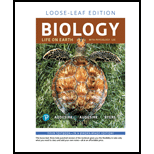
Concept explainers
Introduction: Transfer of energy from one organism to another organism in a linear sequence is called food chain. Food chain starts with producer that is generally a plant and ends with a decomposer that is usually bacteria or other microorganisms.
Answer to Problem 1MC
Correct answer: Option b. “as energy is transferred from one trophic level to the next, some is lost to the environment”.
Explanation of Solution
Reason for the correct answer:
Option b. is given as “as energy is transferred from one trophic level to the next, some is lost to the environment”.
During transfer of energy from one trophic level to the next trophic level, the efficiency of energy transfer is only 10%. For example, if the 10,000 kcal of energy is produced in plants, the herbivorous gets 1000 kcal only and it is again reduced to 100 kcal for carnivorous. It shows that energy is not transferred 100% from one organism or trophic level to the next organism or trophic level.
Hence, option b. is correct.
Reasons for the incorrect answers:
Option a. is given as “a top carnivore requires less energy than a producer”.
Top carnivores get only least amount of energy by energy flow. However, they need more amount of energy for all their activities.
Hence, option a. is incorrect.
Option c. is given as “as nutrient molecules are transferred from one trophic level to the next, some are destroyed”.
Chemical nutrients are recycled back when they are transferred or consumed from one trophic level to the next trophic level by nutrient cycle. They could not be destroyed by the transfer.
Hence, option c. is incorrect.
Option d. is given as “biological magnification of toxic substances kills many top predators”.
Biological magnification is a toxic substance that is stored in fatty tissues and it cannot be destroyed. The concentration of toxic substance increases with the food chain when it goes to high trophic level and it may be fatal to the top carnivores. However, it is not responsible for the abundance or big biomass of plants.
Hence, option d. is incorrect.
Hence, options a., c., and d. are incorrect.
Abundance of producer helps to transfer more energy in food chain because some energy get lost in the environment.
Want to see more full solutions like this?
Chapter 29 Solutions
Pearson eText Biology: Life on Earth with Physiology -- Instant Access (Pearson+)
- Which of the following is not a DNA binding protein? 1. the lac repressor protein 2. the catabolite activated protein 3. the trp repressor protein 4. the flowering locus C protein 5. the flowering locus D protein 6. GAL4 7. all of the above are DNA binding proteinsarrow_forwardWhat symbolic and cultural behaviors are evident in the archaeological record and associated with Neandertals and anatomically modern humans in Europe beginning around 35,000 yBP (during the Upper Paleolithic)?arrow_forwardDescribe three cranial and postcranial features of Neanderthals skeletons that are likely adaptation to the cold climates of Upper Pleistocene Europe and explain how they are adaptations to a cold climate.arrow_forward
- Biology Questionarrow_forward✓ Details Draw a protein that is embedded in a membrane (a transmembrane protein), label the lipid bilayer and the protein. Identify the areas of the lipid bilayer that are hydrophobic and hydrophilic. Draw a membrane with two transporters: a proton pump transporter that uses ATP to generate a proton gradient, and a second transporter that moves glucose by secondary active transport (cartoon-like is ok). It will be important to show protons moving in the correct direction, and that the transporter that is powered by secondary active transport is logically related to the proton pump.arrow_forwarddrawing chemical structure of ATP. please draw in and label whats asked. Thank you.arrow_forward
- Outline the negative feedback loop that allows us to maintain a healthy water concentration in our blood. You may use diagram if you wisharrow_forwardGive examples of fat soluble and non-fat soluble hormonesarrow_forwardJust click view full document and register so you can see the whole document. how do i access this. following from the previous question; https://www.bartleby.com/questions-and-answers/hi-hi-with-this-unit-assessment-psy4406-tp4-report-assessment-material-case-stydu-ms-alecia-moore.-o/5e09906a-5101-4297-a8f7-49449b0bb5a7. on Google this image comes up and i have signed/ payed for the service and unable to access the full document. are you able to copy and past to this response. please see the screenshot from google page. unfortunality its not allowing me attch the image can you please show me the mathmetic calculation/ workout for the reult sectionarrow_forward
 Human Biology (MindTap Course List)BiologyISBN:9781305112100Author:Cecie Starr, Beverly McMillanPublisher:Cengage Learning
Human Biology (MindTap Course List)BiologyISBN:9781305112100Author:Cecie Starr, Beverly McMillanPublisher:Cengage Learning Biology: The Dynamic Science (MindTap Course List)BiologyISBN:9781305389892Author:Peter J. Russell, Paul E. Hertz, Beverly McMillanPublisher:Cengage Learning
Biology: The Dynamic Science (MindTap Course List)BiologyISBN:9781305389892Author:Peter J. Russell, Paul E. Hertz, Beverly McMillanPublisher:Cengage Learning
 Concepts of BiologyBiologyISBN:9781938168116Author:Samantha Fowler, Rebecca Roush, James WisePublisher:OpenStax College
Concepts of BiologyBiologyISBN:9781938168116Author:Samantha Fowler, Rebecca Roush, James WisePublisher:OpenStax College Biology (MindTap Course List)BiologyISBN:9781337392938Author:Eldra Solomon, Charles Martin, Diana W. Martin, Linda R. BergPublisher:Cengage Learning
Biology (MindTap Course List)BiologyISBN:9781337392938Author:Eldra Solomon, Charles Martin, Diana W. Martin, Linda R. BergPublisher:Cengage Learning





